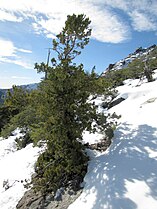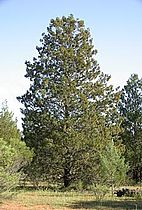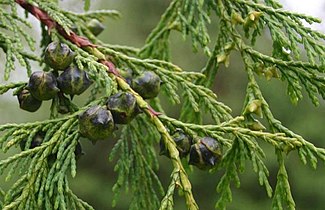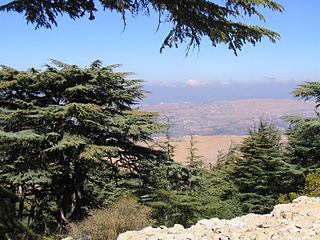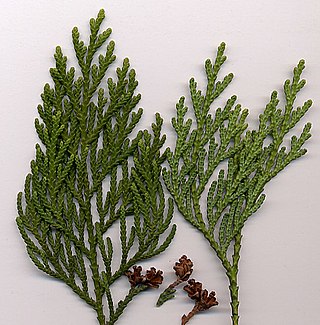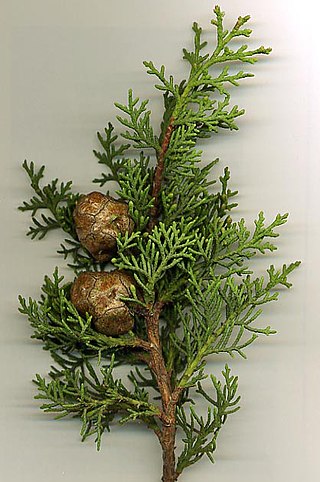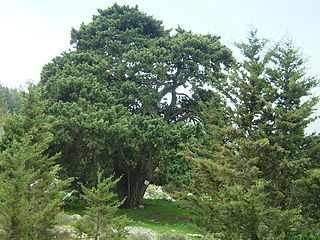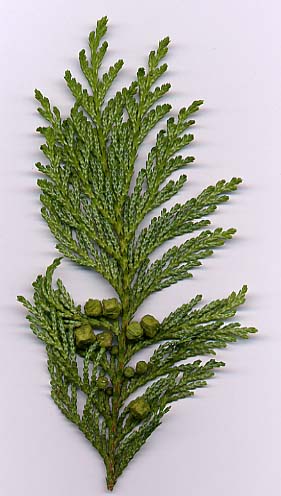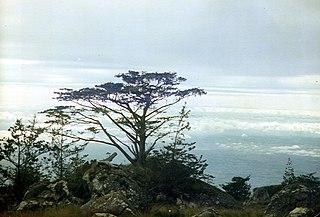Species
Cypress is any of the twelve species of ornamental and timber evergreen conifers constituting the genus Cupressus of the family Cupressaceae. Many resinous, aromatic evergreen trees called cypress belong to other genera of the same family, especially species of false cypress and cypress pine. The name cypress is occasionally used for some species of fustic and for bald cypress, and it often denotes jack pine in eastern Canada. [1]
Species that are commonly known as cypresses include:
- Cypress (multiple species within the genus Cupressus):
- Cupressus sempervirens , a common cypress also referred to as Italian cypress and Mediterranean cypress. [2] It is native to Libya, Cyprus, Iran, Israel, Jordan, Lebanon, Syria, Turkey, and Greece. [2]
- Hesperocyparis lusitanica , commonly known as the Mexican cypress, which is native to Mexico and Central America. [3]
- Chamaecyparis:
- Chamaecyparis lawsoniana , known as the Lawson's cypress or Port Orford cedar. [4] This is a native species to Oregon and northwestern California. [4]
- Taxodium:
- Taxodium ascendens , commonly known as pond cypress [5] and native to North America.
- Taxodium distichum , commonly known as bald cypress and native to the southeastern United States. [6]
- Taxodium mucronatum , commonly known as Montezuma cypress or Montezuma bald cypress. [7] It is native Mexico, Guatemala, and southern-central United States. [7]
- Calocedrus:
- Calocedrus decurrens, which has the common names bastard-cedar, incense-cedar and California incense cedar. [8] They are native to North America, specifically California, Oregon, Nevada, and Mexico. [8]
- Thuja:
- Platycladus orientalis or Thuja orientalis, [9] commonly known as Chinese thuja and native to China and Korea. [9]
- Thujopsis:
Other species include:
- African cypress ( Widdringtonia species), native to Southern Africa [11]
- Bald, Pond, and Montezuma cypresses ( Taxodium species), native to North America
- Chinese swamp cypress ( Glyptostrobus pensilis ), Vietnam, critically endangered [12]
- Cordilleran cypress ( Austrocedrus chilensis ), native to Chile and Argentina [13]
- Cypress-pines ( Actinostrobus species), southwestern Australia [14]
- Cypress-pines ( Callitris species), Australia and New Caledonia [15]
- False cypress ( Chamaecyparis species), Asia and North America. [16]
- Fujian cypress ( Fokienia hodginsii ), southeastern China [17]
- Guaitecas cypress ( Pilgerodendron uviferum ), western Patagonia [18] and Tierra del Fuego [13]
- Japanese cypress ( Chamaecyparis obtusa ), East Asia
- Patagonian cypress ( Fitzroya cupressoides ), southern Chile and Argentina
- Mediterranean cypress ( Cupressus sempervirens ), famous for its longevity, popular garden plant
- Monterey cypress ( Cupressus macrocarpa ), native to the Monterey Peninsula, California [19]
- Nootka cypress ( Cupressus nootkatensis ), native to the Pacific Northwest of North America [20]
- Siberian cypress ( Microbiota decussata )
- Summer cypress ( Bassia scoparia ), in the family Amaranthaceae
- Western red cedar ( Thuja plicata ), native to North America.
- Actinostrobus arenarius
- Austrocedrus chilensis
- Callitris preissii
- Cupressus macrocarpa, Monterey Peninsula, California
- Cupressus nootkatensis
- Fokienia hodginsii
- Fitzroya cupressoides
- Glyptostrobus pensilis foliage
- Taxodium ascendens, Okefenokee Swamp, Georgia (USA)
- Widdringtonia whytei , Malawi

